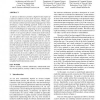ITRUST
2005
Springer
14 years 6 months ago
2005
Springer
Abstract. When we model and analyze trust in organizations or information systems we have to take into account two different levels of analysis: social and individual. Social leve...
COMPSAC
2005
IEEE
14 years 6 months ago
2005
IEEE
To protect software against malicious activities, organizations are required to monitor security breaches. Intrusion Detection Systems (IDS) are those kinds of monitoring tools th...
COMPSAC
2006
IEEE
14 years 6 months ago
2006
IEEE
This paper presents an aspect-oriented approach to integrated elicitation of functional and security requirements based on use case-driven development. We identify security threat...
SEKE
2007
Springer
14 years 6 months ago
2007
Springer
A software architecture provides a high-level description of a software solution in terms of the structure, topology, and interactions between its principal components. While a nu...
PDCAT
2007
Springer
14 years 6 months ago
2007
Springer
A communication protocol is a fundamental component of a multi-agent system. The security requirements for a communication protocol should be articulated during the early stages o...
SECURWARE
2007
IEEE
14 years 6 months ago
2007
IEEE
—In this paper we present an approach for specifying and prioritizing information security requirements in organizations. It is important to prioritize security requirements sinc...
SASO
2007
IEEE
14 years 6 months ago
2007
IEEE
Adaptive security is based on the observation that the security requirements of a system or service heavily depend on the environment in which they operate and should therefore be...
IEEEARES
2007
IEEE
14 years 6 months ago
2007
IEEE
We present a pattern system for security requirements engineering, consisting of security problem frames and concretized security problem frames. These are special kinds of proble...
COMPSAC
2007
IEEE
14 years 6 months ago
2007
IEEE
We present in this paper an adaptive security model for Multi-agent systems. A security meta-model has been developed in which the traditional role concept has been extended. The ...
IEEEARES
2008
IEEE
14 years 6 months ago
2008
IEEE
In this paper, we discuss the use of formal requirementsengineering techniques in capturing security requirements for a Grid-based operating system. We use KAOS goal model to repr...



